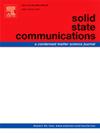Interdiffusion in chalcogenide semiconductor superlattice nanostructures
IF 2.1
4区 物理与天体物理
Q3 PHYSICS, CONDENSED MATTER
引用次数: 0
Abstract
The diffusion intermixing of layers during annealing of epitaxial superlattice nanostructures based on chalcogenide semiconductors (PbS, PbSe, PbTe, EuS, EuSe, SrS) was studed by X-ray diffraction technique. The interdiffusion coefficients were determined basing on changing of the intensity of near-Bragg reflection satellites in X-ray diffraction pattern. Layer materials in superlattices EuS-PbTe and PbS-PbTe are not intermixed.
铬化半导体超晶格纳米结构中的相互扩散
利用 X 射线衍射技术研究了基于铬化半导体(PbS、PbSe、PbTe、EuS、EuSe、SrS)的外延超晶格纳米结构退火过程中的层间扩散混合情况。根据 X 射线衍射图样中近布拉格反射卫星强度的变化确定了相互扩散系数。超晶格 EuS-PbTe 和 PbS-PbTe 中的层材料没有相互混合。
本文章由计算机程序翻译,如有差异,请以英文原文为准。
求助全文
约1分钟内获得全文
求助全文
来源期刊

Solid State Communications
物理-物理:凝聚态物理
CiteScore
3.40
自引率
4.80%
发文量
287
审稿时长
51 days
期刊介绍:
Solid State Communications is an international medium for the publication of short communications and original research articles on significant developments in condensed matter science, giving scientists immediate access to important, recently completed work. The journal publishes original experimental and theoretical research on the physical and chemical properties of solids and other condensed systems and also on their preparation. The submission of manuscripts reporting research on the basic physics of materials science and devices, as well as of state-of-the-art microstructures and nanostructures, is encouraged.
A coherent quantitative treatment emphasizing new physics is expected rather than a simple accumulation of experimental data. Consistent with these aims, the short communications should be kept concise and short, usually not longer than six printed pages. The number of figures and tables should also be kept to a minimum. Solid State Communications now also welcomes original research articles without length restrictions.
The Fast-Track section of Solid State Communications is the venue for very rapid publication of short communications on significant developments in condensed matter science. The goal is to offer the broad condensed matter community quick and immediate access to publish recently completed papers in research areas that are rapidly evolving and in which there are developments with great potential impact.
 求助内容:
求助内容: 应助结果提醒方式:
应助结果提醒方式:


